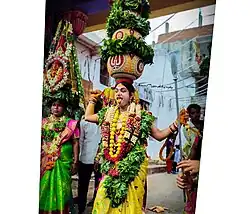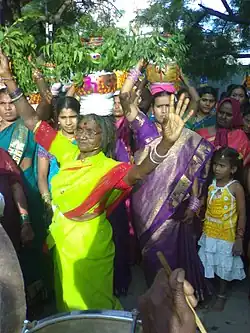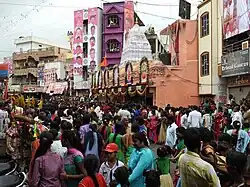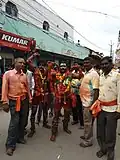Bonalu
| Bonalu | |
|---|---|
 Women with Bonam | |
| Official name | Bonalu |
| Observed by | Telangana |
| Type | Festival of Deccan Shakti-Shaivite tradition. |
| Celebrations | On Sundays |
| Observances | Offering |
| Begins | Ashada masam (July/August) |
| Frequency | Annual |
Bonalu (Telugu: బోనాలు) is a traditional festival centred on the Hindu goddess Mahakali from Telangana.[1] This festival is celebrated annually in the twin cities of Hyderabad and Secunderabad, as well as in other parts of the state.[2] It is celebrated in the month of Ashada Masam, which is around July and/or August. Special "poojas" (worship/ ceremonies) are performed for Yellamma (one of the many regional forms of Mahakali) on the first and last day of the festival.[3] The festival is also considered a thanksgiving to Mahakali for fulfillment of vows.[4]
The word Bonam is a contraction of the word Bhojanam, a loanword from Sanskrit which means a meal or a feast in Telugu. It is an offering to Mahakali. Women prepare rice cooked with milk and jaggery in a new brass or earthen pot adorned with neem leaves, turmeric, and vermilion with a lit lamp on top of the pot. Women carry the pots on their heads and make an offering of the Bonam along with turmeric-vermilion, bangles and sari to Mahakali across the temples.[2]
Origin of Bonalu festival
The origin of this festival can be traced back to the 18th century in the erstwhile Hyderabad State, and is linked with the "Regimental Bazaar" and the twin cities of Hyderabad and Secunderabad. In the year 1813, plague broke out in the twin cities, and this took the lives of thousands of people.[2] Just before this, a military battalion from Hyderabad had been deployed to Ujjaini, where there is a temple of Shiva in the form of Mahakaleshwara. When this military battalion from Hyderabad got news that the epidemic had hit their native land, they became fearful for the lives and safety of their families. The soldiers posted in Ujjaini prayed to the goddess at the Mahakali Temple – Ujjaini, Madhya Pradesh. The battalion is said to have prayed to Mahakali to kill the plague, and if the goddess did so, they would install an idol of Mahakali in the city when they returned home. It is believed that Mahakali destroyed the disease and kept the pestilence away. When the battalion returned to their homeland, they built the Ujjaini Mahakali Temple and installed an idol of the goddess, in fulfilment of their vow. This was followed by the offering of Bonalu to her. This then became a tradition that has been followed by most of the people of Telangana.[4]
_10.jpg)
Pothuraju

According to mythology, Potharaju is the brother of Mahakali. His role is played in the procession by a well-built, bare-bodied man, wearing a small tightly draped red dhoti, bells on his ankles, and anointed with turmeric on his body and vermilion on his forehead. He dances to resounding drums in the procession.[5]
Potharaju always dances in front of the Palaharam Bandi, i.e., the procession. He is considered the initiator of the festivities and the protector of the community. He leads the female dancers who are under the spell of Mahakali (known as shigam) to the temple, with lashing whips and emerald neem leaves (margosa) tied around their waists, accompanied by trumpets and drums.[6]
Rangam
Rangam (or Performing the Oracle), is held the next morning of the festival. A woman standing atop of an earthen pot invokes Goddess Mahakali onto her and performs the custom. She foretells the year ahead for the devotees asking about the future. This takes place before the procession is started.[7]
Ghatam
Ghatam is a copper pot, decorated in the form of the Mother Goddess. The Ghatam is carried by a priest, who wears a traditional Dhoti, and whose body is smeared with turmeric. The Ghatam is taken into procession from the first day of the festival until the last day when it is immersed in water. The Ghatam is usually accompanied by beating of drums.[8]
The festival concludes with immersion of the Ghatam. The Ghatam of Haribowli's Akkanna Madanna Temple[9][10] leads the procession, placed atop an elephant and accompanied by mounted horses and models depicting Akkanna and Madanna. It ends in the evening with a glittering procession and display of much pomp and show followed by immersion of Ghatams at Nayapul.[11]
Gallery
-

-

-

-

-

-

-

-

-

-

-

-

-
 Lighting across the Uppal during Bonalu festival
Lighting across the Uppal during Bonalu festival -

References
- ^ Telangana state portal Language and Culture
- ^ a b c Reddy, Suhasini (20 July 2019). "BONALU Celebrations started in Telangana State with Gaiety". www.thehansindia.com. Retrieved 7 August 2020.
- ^ "The Hindu : The spirit of 'Bonalu'". Archived from the original on 27 February 2008. Retrieved 24 July 2007.
- ^ a b "Bonalu Festival 2019: Vibrant Pictures From the Thanksgiving Festival". News18. 29 July 2019. Retrieved 7 August 2020.
- ^ "Archive News". The Hindu. 24 July 2006. Archived from the original on 23 September 2006.
- ^ "Archive News". The Hindu. 28 March 2007. Archived from the original on 11 July 2012.
- ^ Reporter, Our Staff (7 November 2004). "Government urged to declare holiday tomorrow". The Hindu. p. 03. Archived from the original on 12 July 2004 – via The Hindu (old).
- ^ "Secunderabad awash in Bonalu colours". The New Indian Express. 15 May 2012.
- ^ "Archive News". The Hindu. 15 July 2006. Archived from the original on 30 September 2007.
- ^ "New Page 1". Archived from the original on 24 June 2009. Retrieved 5 April 2009.
- ^ "Archive News". The Hindu. 6 August 2007. Archived from the original on 6 December 2007.